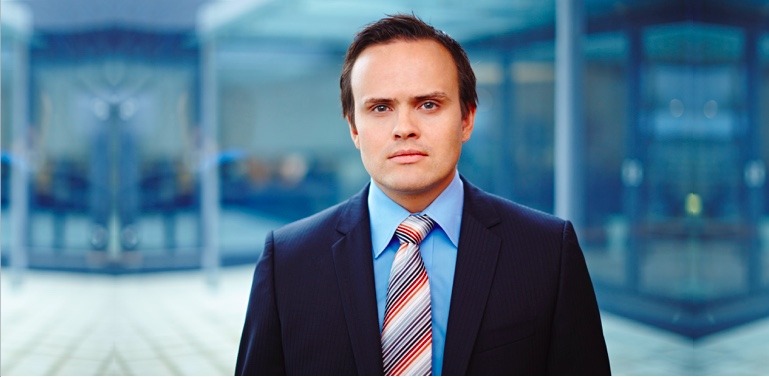By Hamlin Lovell, NordicInvestor
This article forms part of our upcoming report on alternative fixed income in the Nordics
Arion Bank, based in Reykjavik, is one of the largest institutional asset managers in Iceland, managing funds on behalf of pension funds and institutional investors. NordicInvestor interviewed Hjorleifur Waagfjord (pictured below), Head of Institutional Asset Management and Halldór Gretarsson (pictured above), Senior fund manager, at Arion Bank to find out about their growing allocation to direct lending and other credit investments.
For some years, Arion has been diversifying funds under management outside Iceland for several reasons: the Icelandic pension system is quite large relative to local financial markets; as a diversification factor, but also to deal with currency issues and historically capital controls. Currently, the asset management business does not hedge foreign fund exposure back to ISK but this is regularly reviewed. Currency hedging is based on expectations of the relative performance of the ISK against other currencies at each time.
Historically, external managers and funds have been used rather than picking individual bonds on the credit side (apart from government issues).
Growing direct lending allocation outside Iceland
“The main reason for allocating to private debt is yield pickup, and the second reason is diversifying away from the domestic market,” says Waagfjord. The asset management arm have been allocating to direct lending in the domestic market for a long time, but has recently allocated to foreign markets. “The key areas are middle-market direct lending to private equity sponsored companies in the US and Europe,” says Waagfjord. The focus is on the middle-market due to moderate leverage and better financial covenants compared to the broadly syndicated market. Allocations to listed, public debt are in contrast more stable.
The asset manager has been active in the domestic market for alternatives for some time with a 4-7% allocation across portfolios. The foreign alternatives portfolio is smaller but has grown substantially in the recent years and is still growing: commitments currently represent 2-4% of assets and the aim is 5-7%.
Yield pickups
The ballpark return targets for listed credit are usually around a spread of 130-160 basis points over risk free rates for investment grade, and 400-450 basis points for high yield.
For middle-market direct lending the target is usually 400-600 basis points above risk free rates, depending on forms of risk premia in each and every situation.
The outlook is for higher yields: “We sees potential for increases in both risk free rates and spreads,” says Gretarsson.
Cash management and liquidity
Short term liquidly vehicles are shorter duration cash like funds, shorter term (1-2M) deposits and in a rising rate environment the asset management arm has been going further out in the curve. For now, the asset manager invests in funds according to their normal liquidity terms.
Inflation, rates and default risks
The asset manager has a fairly cautious outlook: “the key risk factors identified on our behalf are growing government debt in relation to the Covid response in recent years, escalating global inflation and in that sense higher expected corporate default risks. Higher rates, all else unchanged, put pressure on companies and governments. The interplay between fighting rising inflation while keeping economic growth on a sensible level at the same time is something we worry about” says Waagfjord.
ESG
Most mandates run by the asset manager have formal ESG investment policies, the focus in recent years has been towards the local Iceland market where direct influence and engagement carry more weight. “Overseas the focus has been on external manager policy and guidelines and there we look for international standards like UNPRI signatories,” says Gretarsson. The EU SFDR (Sustainable Finance Disclosure Regime) in Iceland has not yet been implemented locally on a wider scale and is something of a work in progress. “We expect a further development in that direction in the future” says Gretarsson.
Due Diligence: open to new managers
The manager selection process in the asset manager involves a proactive approach, where relationships are built over time. After a manager is identified, there is a three to six months due diligence process, done in house, including on and off-site analysis.
Managers are found through multiple avenues: online databases, direct approaches, external requests from third party marketers and salespeople as well as through seminars, conferences and other pipelines.
“We like to build relationships investing with experienced external managers, but we have no fixed restrictions regarding our investment holding periods,” says Waagfjord. “Each manager is judged on a case-by-case basis as the track record, market opportunities and strategy are reviewed. The minimum length of track record and minimum required assets would depend on a range of factors such as the fund, strategy and fund management group,” explains Waagfjord. Typical approach in the asset management is to look for external managers to build a long-term relationship with intention to invest in a series of funds over a number of years.
Vehicles
The restrictions for most mandates are maximum 20% ratio of a fund (or 25% of a UCITS) and usually the internal guideline in the asset manager is to hold a much smaller percentage.
Fund domiciles are mainly in Ireland and Luxembourg, including Luxembourg partnership structures and there are currently no separately managed accounts.




